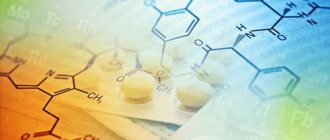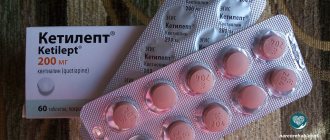Tranquilizers are classified as psychotropic drugs, since the main target of their action is the mental sphere and they are used to treat mental illnesses and painful conditions in healthy individuals. In addition to tranquilizers, psychotropic drugs include antipsychotics, antidepressants, mood stabilizers, nootropics and nervous system stimulants.
The first tranquilizer MEPROBOMAT
was synthesized in 1952. Thus, the history of the use of drugs in this group goes back more than 60 years.
Most drugs in this group, in addition to their sedative effect, have the ability to reduce muscle tension, make it easier to fall asleep, and stabilize autonomic reactions: palpitations, pressure surges, tremors, dizziness and headaches.
Tranquilizers
- a large group of drugs that are different in structure and mechanism of action, but what they have in common is a decrease in the excitability of the subcortical structures of the brain responsible for emotional reactions.
General restrictions for all drugs in this group are incompatibility with alcohol (they enhance each other’s effects), and prohibition on use by persons performing complex responsible actions that require increased concentration and instant reaction (drivers, pilots, machine operators, etc.) .
Depending on the chemical structure, tranquilizers are divided into several groups (according to M.D. Mashkovsky). List of tranquilizers by group:
BENZODIAZEPINES
One of the most common tranquilizers. They are widely used in the practice of psychiatrists, psychotherapists, psychiatrists - narcologists, neurologists, cardiologists, surgeons, anesthesiologists and resuscitators. With long-term use they can cause dependence (mental and physical). Benzodiazepine tranquilizers have a specific antagonist (a drug with the opposite effect) - FLUMAZENIL (anexate), which is used to stop breathing and loss of consciousness in cases of overdose and poisoning with benzodiazepines.
- Chlozepid (Librium, Radepur, Chlordiazepoxide, Elenium). The very first benzodiazepine tranquilizer with a strong sedative effect. Sibazon (Relanium, Relium, Seduxen, apaurin, diazepam).
- Bromodihydrochlorophenylbenzodiazepine (phenazepam, elzepam). Domestic development, widely distributed in the countries of the former USSR.
- Nozepam (tazepam, oxazepam).
- Lorazepam (calmese, loram, lorafen).
- Bromazepam (Lexilium).
- Mezapam (rudotel, medazepam).
- Gidazepam.
- Estazolam (nuctanol).
- Clorazepate (Tranxene).
- Clobazam (freesium).
- Alprazolam (Xanax, Zoldac, Neurol). One of the most powerful drugs in this group.
- Tetrazepam (myolostane).
- Tofisopam (Grandaxin). It is distinguished by its ability to have an activating effect.
Overdose
The use of high doses of benzodiazepine derivatives leads to overdose or intoxication of the body. The condition is life-threatening. Against the background of an increased concentration of metabolites of psychoactive substances in the blood, a person develops a soporotic state (loss of consciousness with preservation of unconditioned defensive reflexes) followed by a transition to a coma.
Progressive intoxication leads to depression of the respiratory center and disorders of external respiration, damage to the renal system, abnormalities of the heart and blood vessels. Symptoms such as cerebral spasms and mydriasis (dilation of the pupil) are also recorded. Increasing intoxication is dangerous due to cardiac arrest.
Basic treatment:
- detoxification of the body - gastric lavage, enema, adsorbents
- introduction of an antidote - Aminophylline or Flumazenil
- symptomatic and supportive therapy
The incidence of death due to overdose of benzodiazepine derivatives is 3.8%, but this figure increases significantly if tranquilizers and sleeping pills were used in combination with ethanol or psychotropic substances. After relief of intoxication, the patient needs to be monitored by a psychiatrist.
Use of tranquilizers
The main indications for taking these drugs are mild mental disorders and behavioral disorders:
- Neuroses. Neurosis-like conditions.
- Personality disorders.
- Anxiety disorders: panic attacks, phobias, generalized anxiety disorder, mixed anxiety and depressive disorder.
- Withdrawal state (withdrawal syndrome) with alcohol, nicotine, drug addiction, substance abuse and polydrug addiction.
- Depression with anxiety.
- Schizotypal disorder.
- Acute psychoses (in combination with other drugs).
- Consequences of organic damage to the central nervous system with mental disorders
- Behavioral disorders in children and adolescents.
- Insomnia.
- Eating disorders (anorexia, bulimia).
- Psychosomatic diseases: eczema, irritable bowel syndrome, “neurogenic bladder”, asthma attacks, hypertension and arrhythmia.
In addition, they are widely used in neurological practice: consequences of traumatic brain injuries, strokes with increased muscle tone, epilepsy, spinal osteochondrosis, etc. In therapeutic practice: functional disorders in the gastrointestinal tract, cardiovascular, urinary and other body systems.
Is it possible to take tranquilizers on your own without a doctor?
No. These are psychotropic drugs that have their own contraindications and limitations. Self-administration is life-threatening.
Can you buy tranquilizers without a prescription?
No. They are prescribed only on prescription by a doctor who has grounds for prescribing this drug. Two tranquilizers are prescribed on special strict reporting prescription forms (form 148 - 1/u - 88), these are sibazon and alprazolam.
What are the most powerful tranquilizers?
Sibazon and alprazolam.
What are daytime tranquilizers?
Since most tranquilizers tend to cause daytime sleepiness, drugs have been synthesized without this side effect. These include: gidazepam, clorazepate, tofisopam, hydroxyzine, mebicar.
What is the difference between tranquilizers and antidepressants? Do they have anything in common?
The difference between them is in the mechanisms of action (they act on different types of receptors). They have different therapeutic effects (anti-anxiety and antidepressant, respectively). Tranquilizers are often prescribed once or in short courses, antidepressants are prescribed for a long time, several months.
What they have in common is that they are all psychotropic drugs. Some drugs from these groups can give a hypnotic, sedative and anti-aggressive effect.
Mechanism of action
A kind of “target” for benzodiazepines is specific GABAergic receptors, which selectively interact with γ-aminobutyric acid, the main “inhibitory” transmitter of the central nervous system. Roughly speaking, it is GABA that protects our brain from emotional overload, regulates higher nervous activity, and indirectly participates in the hormonal regulation of vascular tone, rhythm and heart rate.
The pathogenetic rationale for prescribing benzodiazepines is that at the biochemical level, when they are used, the sensitivity of GABA receptors increases. This allows the use of such medications to relieve alcohol and drug withdrawal, accompanied by:
- severe sleep disturbances;
- generalized convulsive seizures;
- phobic, anxiety and panic disorders.
and an effective rehabilitation program
The effects of drugs do not go away without a trace - even after a person has long stopped drinking or using, he will suffer from depression, fatigue, his mind will be slow to think, and periodically he will be overcome by cravings for drugs or alcohol. There will be other consequences. Drug treatment clinics offer withdrawal symptoms, conversations with psychologists, medications for depression, insomnia, and other methods. However, we do not recommend drug treatment for psychological problems, as this will lead to a change from one addiction to another. Psychiatric medications have side effects, including addiction.
Rehabilitation will help restore a good state of mind. We have all the resources and methods to help you cope with the reasons for using, overcome the consequences, gain the skills and knowledge to effectively cope with problems and build your future.
Drug addiction is not a death sentence. Everyone can live a full life. Call us now!
Share:
TOP 10 most dangerous drugs in the world
Methaqualone - sleeping pill or narcotic
Classification of anxiolytics according to T. A. Voronina and S. B. Seredinin [2]
I. Traditional anxiolytics
- Direct agonists of the GABAA-benzodiazepine receptor complex (benzodiazepine derivatives).
- Preparations of different chemical structures (benactizine, tetramethyltetraazabicyclooctanedione, oxylidine and others).
II. New anxiolytics
- Partial agonists of benzodiazepine receptors - zolpidem, gidazepam and others.
- Endogenous regulators of the GABAA-benzodiazepine receptor complex (endosepines, derivatives of β-carboline, nicotinamide and others).
- Agonists of the GABAB receptor complex.
- Membrane modulators of the GABAA-benzodiazepine receptor complex (ethylmethylhydroxypyridine succinate, fabomotizol and others).
- Glutamatergic anxiolytics.
- Serotonergic anxiolytics (buspirone, ondansetron and others).
- β-blockers - propranolol and others.
- Metabolites of nucleic acids.
- Substances that affect the energy status of the brain.
- Hormonal substances.
- Anxiolytics based on neuropeptides.
- Various substances.
In clinical practice, traditional and some representatives of new anxiolytics are most often used. We will dwell on them in detail.
What should you warn the client about?
When taking axinolytics, drinking alcoholic beverages is unacceptable, since alcohol enhances the inhibitory effect of the drugs on the central nervous system. This may be accompanied by a number of side effects, including respiratory depression, loss of consciousness, as well as paradoxical reactions - agitation, aggressive behavior, and so on.
In addition, it should be borne in mind that anxiolytics can potentiate the effects of other drugs that depress the central nervous system, in particular, hypnotics, antipsychotics with sedative effects, antihistamines with sedative effects, muscle relaxants and others.
Sources
- Polkovnikova Yu. A., Stepanova E. F. Possibilities of creating prolonged dosage forms of afobazole: review. — 2011.
- Voronina T. A., Seredenin S. B. Prospects for the search for new anxiolytics // Experimental and clinical pharmacology, 2002. T. 65. No. 5. P. 4–17.
- Clinical pharmacology and pharmacotherapy: textbook. — 3rd ed., add. and processed / ed. V. G. Kukesa, A. K. Starodubtseva. - M.: GEOTAR-Media, 2012. - 832 p.
- Dyukova G. M. Grandaxin in clinical practice // Treatment of nervous diseases, 2005. No. 2. P. 25–29.
- According to GRLS data as of 06/06/2021.
- Avedisova A. S. Afobazole is a safe drug for the treatment of anxiety in general practice // Russian Medical Journal, 2006. T. 14. No. 22. P. 1–3.
- Voronina T. A. Mexidol: main neuropsychotropic effects and mechanism of action // Pharmateka, 2009. T. 6. P. 28–31.
- Levin O. S. Use of buspirone in clinical practice // Journal of Neurology and Psychiatry named after. S. S. Korsakova, 2015. T. 115. No. 4. P. 83–87.
- Zyablitseva E. A., Pavlova I. V. Effect of the GABA receptor agonist phenibut on the impulse and interaction of neocortical and hippocampal neurons in emotionally negative situations // Russian Physiological Journal named after. IM Sechenov, 2009. T. 95. No. 9. P. 907–918.
- Brachkova D. S., Kolesnik V. A., Mironchenko S. I. Phenibut - a new stage in the development of nootropic drugs, 2014.
Benzodiazepine abuse and addiction
Among the effects and negative consequences caused by taking benzodiazepines, one can separately note addiction and the emergence of cravings for the drug. And it doesn’t matter whether the person took it to treat a real illness or for narcotic purposes. In both cases (if the drug is taken without the supervision of a doctor), there is a need to increase the dose or switch to other drugs. There is a risk of overdose and all other consequences of drug addiction.
The reason for drug use (including pharmaceutical drugs) is a person’s problems that he cannot solve. For example, bad mood or depression, irritability due to drug withdrawal, problems with sleep, etc. And if a person uses medications for narcotic purposes, he also has reasons to do this. For example, problems in communication, at work, in the family, complexes, negative thoughts, etc.
The mechanism is something like this:
- A person tries a drug and his problems fade into the background, he feels happy and carefree.
- The action ends, the feeling of happiness goes away and problems pile up again.
- The person will want to take the dose again because he felt better with it.
- At the same time, his condition will gradually become worse and worse. The pills will bring less and less pleasure, and when the effect of the dose wears off, he will feel worse than before when sober. And in addition to unresolved problems, others will be added that will put pressure.
Thus, addiction and deterioration of a person’s condition will provoke him to take drugs, whether pharmaceutical or illegal.









